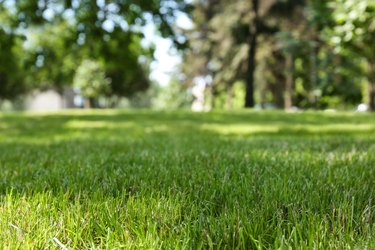
Identifying the variety of Caribbean grass growing on the island of Jamaica is a lesson in the island's geography and history. Jamaica is a mountainous island directly south of Cuba in the Caribbean Sea. About half the island is 1,000 feet above sea level, and it is actually the tip of a mountain that reaches to the bottom of the sea. Its hills are ideal for agriculture and raising farm animals while the beaches are pristine. A variety of grasses have been introduced to the island during its history, but Guinea Grass (Megathyrsus maximus) is one of the few native grasses.
Guinea Grass is Pasture Grass
Video of the Day
The hot and humid climate of Jamaica and its rich soil have been welcoming to a variety of grasses introduced from other areas of the Caribbean and Africa. However, guinea grass is one of the original Caribbean grasses found in Jamaica and is primarily used for forage in pastures. Its seeds are dispersed by the wind, allowing it to spread. Deep underground rhizomes enable it to replenish quickly after environmental hazards such as hurricanes and fire, and the grass can withstand long periods of drought.
Video of the Day
Growing Grass in Jamaica
With its sunny climate and salt air, grass grown successfully in Jamaica must adapt to the climate to survive. One of the most adaptable grasses is China grass (Boehmeria nivea), and its historic use is in the manufacture of ramie, a type of fiber used for cloth making. Introduced to Jamaica in the 1930s, its uses go beyond the loom and it is known as a forage and turf grass. Grown in the lower altitudes of Jamaica, it was originally produced for export.
Another grass common to Jamaica is Signal Grass (Brachiaria decumbens), known as a forage grass. It grows well in non-fertile pastures and can be cut or baled for hay. It is useful as a cover crop and controls weeds and insects. It needs a frost-free, rainy environment but is sensitive to salt air. Signal grass has a deep root system which helps prevent soil erosion. This grass, can, however, be toxic to ruminants, especially during hot and wet conditions when it might produce fungal growth.
A Relative of Bamboo
Elephant Grass (Pennisetum purpureum) is one of the most valuable forage, hay and silage crops in the tropics. Also used for boundary control, dune stabilization, erosion control or as a windbreak, this relative of the bamboo is a robust perennial that can tolerate a monsoon climate. Its uses are multipurpose as feed for livestock and for humans in the preparation of soups and stews. Elephant grass does not like wet feet and tolerates a dry climate best. It also prefers full sun.
Use of Versatile Bermuda Grass
Common in most southern states as well as in the Caribbean, Bermuda grass (Cynodon dactylon) is an extremely hardy perennial grass used to sod sports fields as well as lawns, as well as for forage. Tolerant of floods and drought, the versatility of Bermuda grass makes it popular with tourist attractions as well as non-commercial venues. The species is also a weed that originated in the African Savannah and India before importation to the Caribbean islands.
Medicinal Use for Jamaican Water Grass
Jamaican Water Grass (Zebrina pendula) is used around the world as treatment for diabetes. It has been proven that this zebra-patterned grass lowers blood sugar levels and reduces the sores that are associated with diabetes. Known as the Wandering Jew in American landscape lexicon, its vining growth is familiar to U.S. gardeners.